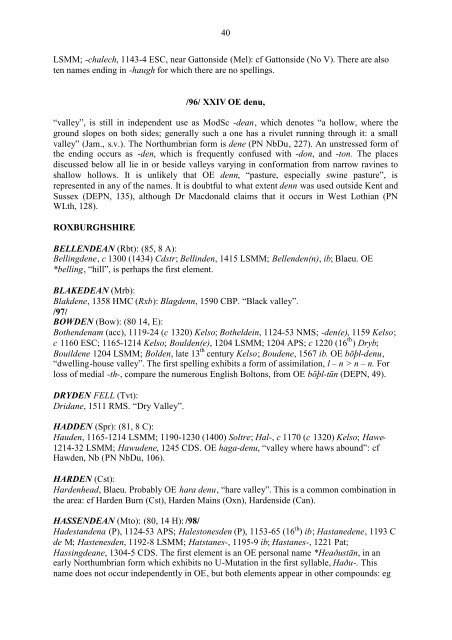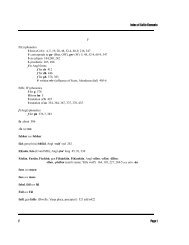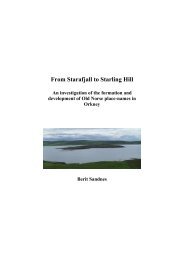May Williamson: The Non-Celtic Place-Names of the Scottish Border ...
May Williamson: The Non-Celtic Place-Names of the Scottish Border ...
May Williamson: The Non-Celtic Place-Names of the Scottish Border ...
You also want an ePaper? Increase the reach of your titles
YUMPU automatically turns print PDFs into web optimized ePapers that Google loves.
40<br />
LSMM; -chalech, 1143-4 ESC, near Gattonside (Mel): cf Gattonside (No V). <strong>The</strong>re are also<br />
ten names ending in -haugh for which <strong>the</strong>re are no spellings.<br />
/96/ XXIV OE denu,<br />
“valley”, is still in independent use as ModSc -dean, which denotes “a hollow, where <strong>the</strong><br />
ground slopes on both sides; generally such a one has a rivulet running through it: a small<br />
valley” (Jam., s.v.). <strong>The</strong> Northumbrian form is dene (PN NbDu, 227). An unstressed form <strong>of</strong><br />
<strong>the</strong> ending occurs as -den, which is frequently confused with -don, and -ton. <strong>The</strong> places<br />
discussed below all lie in or beside valleys varying in conformation from narrow ravines to<br />
shallow hollows. It is unlikely that OE denn, “pasture, especially swine pasture”, is<br />
represented in any <strong>of</strong> <strong>the</strong> names. It is doubtful to what extent denn was used outside Kent and<br />
Sussex (DEPN, 135), although Dr Macdonald claims that it occurs in West Lothian (PN<br />
WLth, 128).<br />
ROXBURGHSHIRE<br />
BELLENDEAN (Rbt): (85, 8 A):<br />
Bellingdene, c 1300 (1434) Cdstr; Bellinden, 1415 LSMM; Bellenden(n), ib; Blaeu. OE<br />
*belling, “hill”, is perhaps <strong>the</strong> first element.<br />
BLAKEDEAN (Mrb):<br />
Blakdene, 1358 HMC (Rxb): Blagdenn, 1590 CBP. “Black valley”.<br />
/97/<br />
BOWDEN (Bow): (80 14, E):<br />
Bo<strong>the</strong>ndenam (acc), 1119-24 (c 1320) Kelso; Bo<strong>the</strong>ldein, 1124-53 NMS; -den(e), 1159 Kelso;<br />
c 1160 ESC; 1165-1214 Kelso; Boulden(e), 1204 LSMM; 1204 APS; c 1220 (16 th ) Dryb;<br />
Bouildene 1204 LSMM; Bolden, late 13 th century Kelso; Boudene, 1567 ib. OE bōþl-denu,<br />
“dwelling-house valley”. <strong>The</strong> first spelling exhibits a form <strong>of</strong> assimilation, l – n > n – n. For<br />
loss <strong>of</strong> medial -th-, compare <strong>the</strong> numerous English Boltons, from OE bōþl-tūn (DEPN, 49).<br />
DRYDEN FELL (Tvt):<br />
Dridane, 1511 RMS. “Dry Valley”.<br />
HADDEN (Spr): (81, 8 C):<br />
Hauden, 1165-1214 LSMM; 1190-1230 (1400) Soltre; Hal-, c 1170 (c 1320) Kelso; Hawe-<br />
1214-32 LSMM; Hawudene, 1245 CDS. OE haga-denu, “valley where haws abound”: cf<br />
Hawden, Nb (PN NbDu, 106).<br />
HARDEN (Cst):<br />
Hardenhead, Blaeu. Probably OE hara denu, “hare valley”. This is a common combination in<br />
<strong>the</strong> area: cf Harden Burn (Cst), Harden Mains (Oxn), Hardenside (Can).<br />
HASSENDEAN (Mto): (80, 14 H): /98/<br />
Hadestandena (P), 1124-53 APS; Halestonesden (P), 1153-65 (16 th ) ib; Hastanedene, 1193 C<br />
de M; Hastenesden, 1192-8 LSMM; Hatstanes-, 1195-9 ib; Hastanes-, 1221 Pat;<br />
Hassingdeane, 1304-5 CDS. <strong>The</strong> first element is an OE personal name *Heaðustān, in an<br />
early Northumbrian form which exhibits no U-Mutation in <strong>the</strong> first syllable, Haðu-. This<br />
name does not occur independently in OE, but both elements appear in o<strong>the</strong>r compounds: eg




